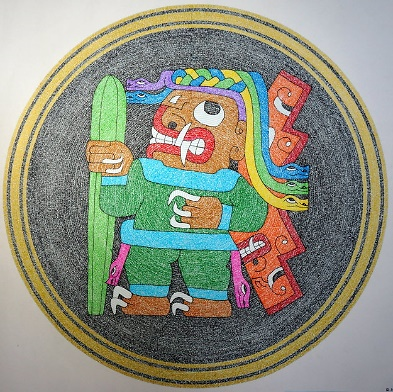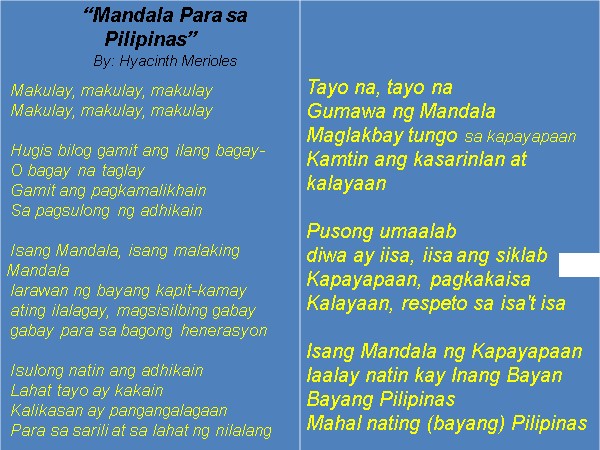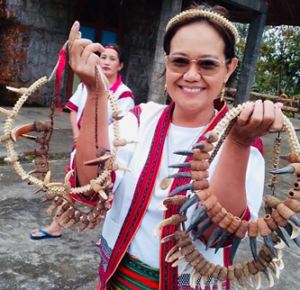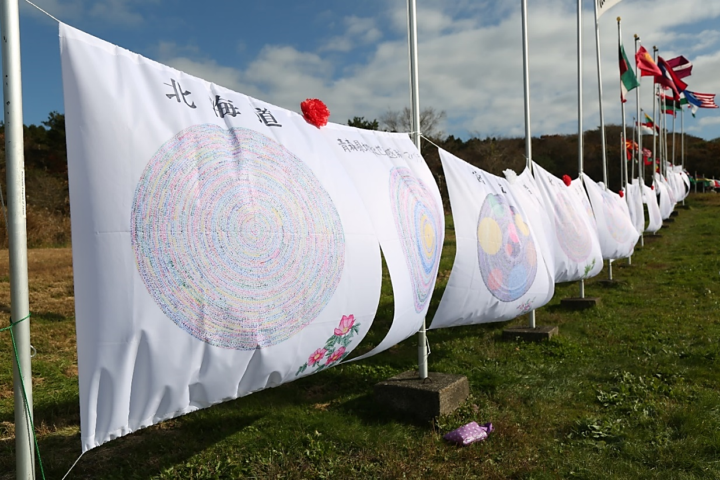SPIRITUALITY
by Genevieve Balance-Kupang
The joy of seeing accomplished mandalas is but one of the humble responses to the overwhelming challenge of creating a new culture. It draws one to experience and appreciate beauty, creativity, uniqueness, the mystery of life, and the longing for peace and wellness. One sees the divine imprint of God’s creativity in each process. Mandalas are inspiring limitless tools for creating peace, understanding, and healing.
The process of creating mandalas acknowledges Ken Wilber’s great nest of spirit: a holistic mandala of transcendence and include-kosmic mandala; Carl Jung’s process of individuation, Rolf Satler’s “a dynamic mandala,” Thomas McFarlane’s integral sphere, Matthew Fox’s creation spirituality, and Fr. Francis Senden, CICM’s philosophy of part and whole as the theoretical orientations.
Integrating these theories and philosophy in our life could help how we relate, assess reality, and forge where we want to go. For example, under Creation Spirituality, we honor all of creation as original blessings that integrate Eastern and Western spirituality and global indigenous cultures with the emerging scientific understanding of the universe and the passion for creativity. It is both a tradition and a movement, celebrated by mystics and agents of social change in every age and culture.
In this fourth article, I would like to add what Jenny Funston shared in 2012. She posits that the mandala is an incredible ‘vehicle’ for going into deep meditation and allowing many ‘unknown’ options to surface unimpeded. She used mandala as a tool for her peacemaking activities, promoting the culture of life, sustainability, environmental stewardship, praising the Creator, and acknowledging oneself as a part of the web of life in the universe. In writing mandalas, it takes a varying amount of time to finish one depending on the size of the paper, the interval between lines and how small she writes. This can vary depending on her specific intent. Even in a workshop this may vary a lot depending on the time allowed, the size of the mandala, how big or small a person writes, how fast or slow one writes, and other variables. She would never push a participant to achieve a specific result. In a normal workshop, her idea is to teach the technique and experience writing 2-3 smaller mandalas. Then, her participant/s can decide whether they wish to pursue the activity with either similar-sized papers or graduate to something a little bigger and/or more complex.
Stanislav “Stano” Ujhazi: (Slovakia-Japan) “Mandala is a symbol of oneness and complete perfection.”

Shaman from Chavin. Mandala credit: Stanislav “Stano” Ujhazi. Mandala created during a trip to Peru and he worked with some shamans.
I came to know Stanislav Ujhazi, “Stano” in 2012 through Mario “Toots” Fungo, who eventually became our soul brother in the peace movement and a great support of our peace activities in the Philippines. He is a resident of Atsugi-shi, Kanagawa-ken, Japan and was connected to 神奈川工科大学 or Kanagawa Institute of Technology. Klara Hodnicova from Slovakia was his facilitator when he had his first mandala workshop in 2000. Since then, he had been creating various types of mandalas, i.e. geographic ones or of natural features, and gave them mostly to people as presents. Playing musical instruments enables him to express his emotions but writing mandalas was his way to relax, concentrate and aids his meditation. The process of writing enabled him to release some very spontaneous emotions and thoughts from his subconscious mind. He added:
“For me, a mandala is a symbol of oneness and complete perfection. I do not know how to comment on it further, but I urge people to try to do it and then you will know yourselves. For me, there is no doubt that the process of making the mandala uncovers insights about one’s inner life and life in relation to the cosmos. The reason why I love mandalas is that they bring about purifications and bring insights into the experiences of life.”

2017 Mandala Exhibit and Ceremony for Peace, Japan. Photo credit: Byakko Shinko Kai via Stanislav Udjazi
Making a mandala is a very refreshing experience. Not only making, but also looking, can be a very rejuvenating experience too. But what we do with our creative energy that is the mind and this physical body is our choice: either we create or destroy. It is the same energy.
To me, the benefits of creating mandalas include all the treasures of life like rejuvenation, relaxation, meditation, peace, love, joy, among others. It brings focused energy and creates a field of prayer or meditation. It is a wonderful tool for this kind of practice. I further add that the natural purification of sub-consciousness was and is consequently possible. Definitely, creativity is expressed and supported me more and more. Imaginations and ideas are coming right after the relaxation of the mind. One thing I discovered during the writing of my mandalas is that I have a lot of interesting emotions hidden within my own mind and that there is still a lot to be discovered.
Hyacinth Merioles ( Manila, Philippines): International Studies degree holder, law apprentice, singer, composer, entrepreneur, and researcher.
She is active in advocacy works and networks with like-minded peace organizations. She composed and readily shared a song titled “Mandala para sa pagsulong ng adhikain para sa Pilipinas” (Mandala in advancing advocacy for the Philippines).

Hyacinth Merioles and her child looking at what is imprinted on the cloth mandala.
International Day of Peace Celebration held at the Quezon City Circle in 2011.

Hyacinth Merioles’ own song composition in Filipino
Shinjin Denise Ferlazzo (New Jersey, USA)
Shinjin Denise, the US Representative of BSK, has expressed peace and light to all. The late Mario Fungo requested her to participate in this mandala research since he knew that Denise has been a peace advocate since the 1970s. I found her response distinct. She said: “Whatever task we do, whether it is mandalas, the INS, or prayer, a pathway has already been opened from the higher divine vibrations to the third-dimensional world. We participate and connect with this pathway. Our bodies are used to bring the higher divine vibrations to the third-dimensional world. The “divine pioneers” began this work when Goi Sensei was alive on Earth. It is now much easier for the higher dimensions to get through to the third dimension world. The pathways are cleared and fine-tuned, so to speak. Therefore, the INS, prayers, mandalas, and all divine tasks are much more powerful in their effect in the third-dimension world.
She quoted from Masami Saoinji that “the Divinity “IN” is a gift of love from the universe to humanity. The universe is filled with infinite power which is in all human beings. It is a tool for the affirmation of our divinity and purpose as divine beings, helping us to achieve greater harmony, peace and true happiness in our daily lives, and to contribute to the spiritual evolution and enhancement of humanity and our planet.”
Performing the “IN” purifies us, raises our vibrations and completely attunes us with the universal laws of harmony and truth, and with the energy of love. The extent of one’s faith, spiritual awareness or pureness of heart has no bearing on the effectiveness of the Divinity “IN”. It may be practiced by anyone.
In the 3rd dimension, the way you get something to happen is like this: Spirit -> Thought -> Emotion -> Effort -> Manifestation. From coininfo.com “that is, from a theta or spirit level one needs to intend for something to be in a certain way. One needs to somehow form the thought of it or visualize what exactly is needed. Then one needs to feel the need for it, and the willingness to work at it. Then one needs to actually produce the physical effort needed to produce it. Then finally one gets the manifestation of one’s desire.”
Like Nicole Cressiot from France, Diana Joy & Elena Becu from the United Kingdom, Jenny Funston from Australia, and Maria Caterina Putignano from Italy, Toots from the Philippines, all wrote in a pamphlet:
“Bright, positive words carry a wonderful energy and power. Words of gratitude, beauty, kindness, compassion, encouragement, joy, and love are expressions of our original, shining self. Bright words illuminate our dark and gloomy heart, envelop us in warmth, comfort our fears and anxieties, and awaken trust in us. They give us courage and power when we face difficulty or despair.
When we create a mandala using bright, positive words, we are imbuing ourselves with the qualities that we want most. We are calling those qualities forth from our universal source. We are instilling them in our consciousness, in our bodies, and in the atmosphere that we are projecting. If you want to be a deeply loving person, you can write a mandala using a phrase like infinite love. If you want to live more energetically, you can write a mandala with words like energy and energetic. Whatever divine qualities you long for, you can summon them from within the boundless universe and project them into your mind and into your way of life by writing bright words of mandala.”
Another remarkable article which they wrote is entitled “Sending healing energy to nature.”I have also put into practice the essence of the following since I learned about this phenomenon:
“All things created by human hands originally came from nature-from the sun, air, water, earth which includes animals and plants. We human beings tend to take the gifts of nature for granted, often misusing them for our own benefit. To infuse the Earth and the environment with love and gratitude, we need to change our way of thinking and create new habits.”
I have consciously put into practice their friendly advice, and found them helpful. I feel that the third level of consciousness in me is always activated when I am in this state of consciousness. I feel the light that emanates from within whenever I feel very conscious to say gratitude for all the blessings and bounty that we enjoy from nature and of course to God who has created them for us.
We appreciate your time reading and sending comments about this mandala series, and all our other articles. In case you missed the previous articles, here are the links:
https://www.pressenza.com/2021/04/mandala-as-a-symbol-of-the-self-spirituality-and-whole ness/
https://www.pressenza.com/2021/04/the-phenomenon-of-man-dala-making/
https://www.pressenza.com/2021/04/mandala-making-lived-experiences-and-reflections-of-my-co-workers/
About the writer:


Genevieve Balance Kupang (Genie) is an anthropologist, consultant, researcher, and advisor to individuals and organizations engaged in working for good governance, genuine leadership, justice, integrity of creation, peace, the indigenous peoples, preservation of cultures, and societal transformation processes. She is a peace educator, author, an interreligious dialogue practitioner, and resource person with a career in the academe and NGO.






